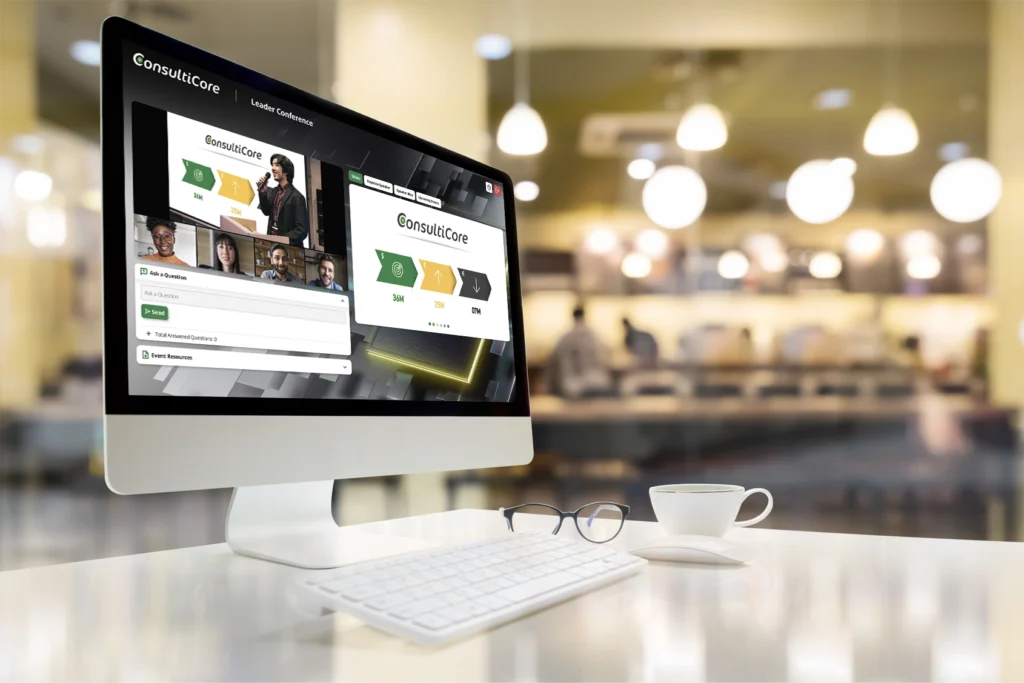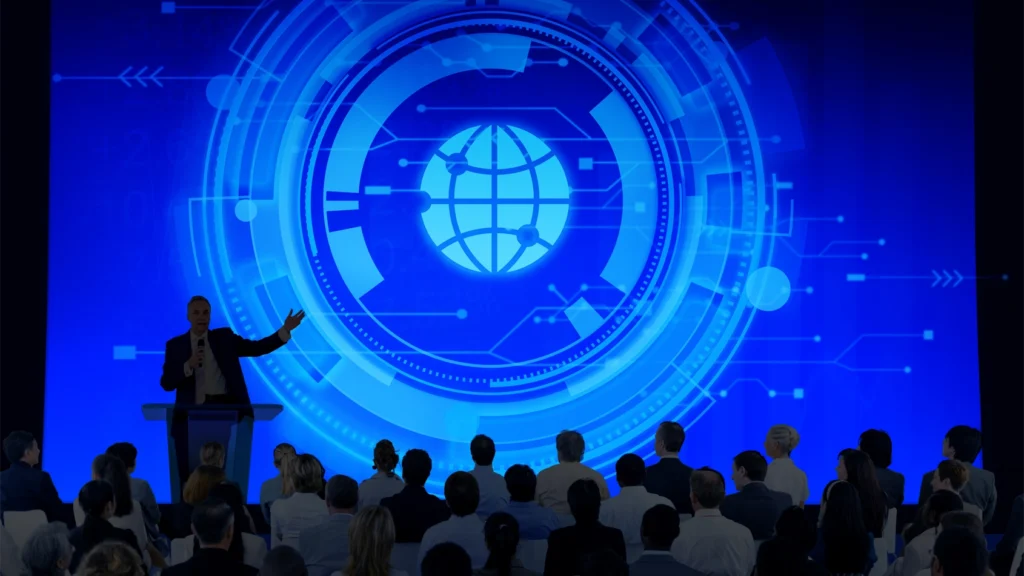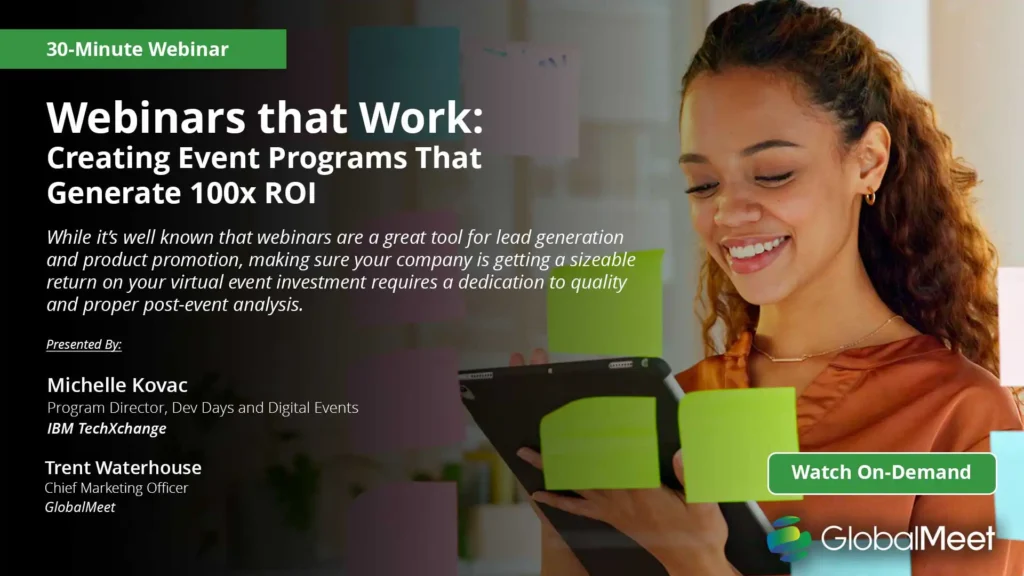
How to Make Virtual Events More Engaging: Tools, Tips & Best Practice
- by GlobalMeet Blog Team
- ,
In an era where remote work and virtual events have become the norm, one question remains at the forefront of every host’s mind: how to make virtual events more interactive and engaging. Whether you’re running a team check-in, a client workshop, or a virtual event with hundreds of participants, event engagement can make or break the success of your session.
Bland, one-way communication isn’t just ineffective — it leads to distracted attendees, reduced productivity, and missed opportunities for collaboration. But with the right strategies and technology, you can turn routine online events into dynamic experiences that keep participants focused, involved, and even excited.
Common Virtual Event Engagement Challenges
There are a number of reasons why virtual events often fall flat. Understanding these reasons is half of the journey towards better, more engaging virtual events.
Passive Participation
Too many virtual events rely on a single speaker and a sea of muted microphones. This passive format discourages interaction and makes it easy for attendees to zone out. The solution is simple. Break up the monotony. Incorporate regular participation opportunities such as polls, Q&As, or short discussion prompts.
Screen Fatigue
Long sessions filled with back-to-back slides drain attention spans. The average participant starts checking emails within 10 minutes if there’s no interaction. So, the best approach is to keep events concise and varied, and use a mix of content formats — videos, whiteboards, breakout discussions — to hold attention.
Technical Barriers
Unfamiliar platforms or lack of accessibility features (like captions or mobile-friendly interfaces) can exclude or frustrate attendees. Choose tools that are intuitive, built with accessibility in mind, and are easy to access from any device.
Lack of Structure
Virtual events without a plan can feel chaotic or directionless, especially for larger groups. Always share an agenda in advance and stick to a structured flow that includes time for interaction.
Why Interactive Elements Matter in Virtual Events
Virtual doesn’t have to mean disconnected. When events are designed with interactivity and engagement in mind, you unlock several benefits:
- Increased focus: Interactive features reduce multitasking and increase information retention.
- Better collaboration: Real-time feedback and discussion foster deeper engagement.
- Higher satisfaction: Attendees leave feeling heard and involved, not talked at.
- Actionable insights: Tools like polls and live chat give you valuable input from attendees.
In short, adding interactive components helps recreate the collaborative energy of in-person meetings in a digital space.
Tools and Techniques to Boost Virtual Event Engagement
Creating truly engaging virtual events is about more than just the content that you’re sharing. It requires a partnership of thoughtful facilitation, and the right tools.
Breakout Discussions
Breakout rooms allow for small group discussions, brainstorming sessions, or focused tasks. They’re ideal for smaller team retrospectives, icebreakers and networking, and problem-solving discussions. With clear instructions and a facilitator assigned to each room they can make a real impact.
Live Reactions
Simple but powerful — reactions like thumbs-up, applause, or emojis give participants a way to respond instantly without interrupting the flow. This helps presenters read the virtual room and adapt their style on the fly.
Polls and Quizzes
Live polls engage attendees by asking for opinions or checking knowledge. These are perfect for keeping the energy high and gauging audience sentiment. Use polls to kick off a discussion or wrap up a section with a quick knowledge check to ensure that your participants are paying attention.
Gamification
Adding game-like elements — points, leaderboards, scavenger hunts, or virtual badges — makes learning and participation a little more fun. You can use gamification during training or team-building sessions to boost involvement.
Virtual Whiteboards
Collaborative Whiteboards are an often underused tool, but they can be a gamechanger in smaller scale virtual meetings where real-time collaboration is king. Map out tasks, visually brainstorm and co-create in real time, and co-design workflows seamlessly with screen sharing to talk through the more complex elements.
Best Practices for Structuring an Engaging Virtual Event
Even with the best tools, event engagement will lag without thoughtful planning. Here’s how to structure events that foster participation from the start.
Set Clear Objectives: Start with the outcome in mind. What should participants walk away with? Tailor your interactive elements to support those goals.
Design for Participation: Make interactivity a requirement, not a bonus. Plan intentional moments for audience involvement every 5–10 minutes.
Use an Experienced Moderator: Whether it’s a facilitator or co-host, someone should guide the discussion, manage chat questions, and ensure all voices are heard.
Mix Presentation Styles: Break your meeting into segments — slides, videos, breakout groups, polls — to maintain energy and avoid fatigue.
Close with Engagement: Wrap up with a final poll, word cloud, or round of reflections to give everyone a voice and reinforce takeaways.
Elevate Virtual Meeting Engagement with GlobalMeet
Interactive Engagement Features
From live polling and Q&A to real-time reactions and content sharing, GlobalMeet makes it easy to involve participants throughout your event.
Live Transcription and Summaries
Never miss a beat with live captions, automated meeting transcripts and key point summaries — great for keeping everyone aligned.
Enterprise-Grade Security
When it comes to virtual event engagement, InfoSec compliance matters. GlobalMeet meets rigorous enterprise security standards, giving IT peace of mind.
Whether you’re hosting a high-stakes webinar or a recurring team sync, GlobalMeet helps ensure your virtual events are more than just video calls.
Conclusion
Virtual and hybrid events are here to stay, but they don’t have to stay boring. With the right structure, tools, software, and intention, you can build interactive webcasts and events that boost engagement, spark innovation, and deliver better outcomes every single time.

CPD and Training: The Growing Role of Virtual Events in Professional Development
- by GlobalMeet Blog Team
- ,
In a world where skills evolve rapidly and industry standards update frequently, Continuous Professional Development (CPD) has never been more important. For professionals aiming to stay competitive and relevant in their fields, regular training is essential. Traditionally, this meant attending in-person workshops, seminars, and conferences to maintain mandatory training compliance standards. But in recent years a dramatic shift has occurred. Virtual events are now transforming how individuals and organizations approach CPD, offering more accessible, flexible, and scalable learning solutions.
From live webcasts to immersive certification courses, virtual learning environments are empowering professionals across sectors to pursue ongoing development without the constraints of travel, time, or budget.
The Shift to Virtual Training
The global pivot to remote work during the COVID-19 pandemic sparked a massive wave of digital transformation, and one area that underwent significant evolution was professional development and training. Organizations that once relied on in-person seminars and training sessions were forced to explore digital alternatives, revolutionizing the training industry forever.
What began as a temporary necessity soon became a long-term strategy with companies across professional industries recognizing the value of virtual CPD events. With benefits from cost savings and time efficiency, to broader participation opportunities and better tracking, it’s clear to see why the move to virtual CPD has become so popular with the global workforce.
Today the trend continues. The rise of hybrid work environments combined with the increasing globalization of teams has resulted in virtual events no longer being seen as second best, with Think Learning reporting that 73% of L&D professionals expect to spend less budget in the future on instructor-led training, while 79% expect to spend more on online learning. Far from being the secondary option, Virtual Events are emerging as the preferred choice for delivering high-quality professional training at scale.
Why Choose Online Learning?
Virtual learning offers a number of advantages over traditional in-person training, making it a compelling alternative, or complimentary, choice.
Flexibility and Convenience
With virtual learning events professionals can attend training sessions from anywhere in the world, allowing them to slot training and development effortlessly into their already busy schedules. The LinkedIn 2018 Workplace Learning Report notes that 58% of employees prefer opportunities to learn at their own pace, whilst 49% prefer to learn at the point of need, making virtual learning an obvious choice. Whether that’s during flex time, or fitted around other commitments, virtual learning offers dynamic scheduling to ensure that time isn’t diverted away from key responsibilities.
Scalability
Virtual CPD events can reach hundreds — or thousands — of participants simultaneously, with state-of-the-art software platforms providing bespoke set up and support for ease of use. This makes them ideal for large organizations that need to roll out consistent training across multiple departments or geographic regions, without sacrificing event quality.
Cost-Effectiveness
Without the overheads of venue hire, catering, hotel, printing, and travel expenses, virtual events offer a more budget-friendly and sustainable solution. This cost reduction can increase access to training for more staff, and allow for investment in higher-quality content for future events.
Personalized Learning
With the aid of learning management systems (LMS) and AI-powered tools, the best virtual event platforms can tailor content to individual learners, making the experience more interactive, engaging, and accessible. Whether through adaptive quizzes or personalized modules, online learning is often more able to meet diverse professional needs when compared with traditional in-person training.
Types of Virtual CPD Events
There’s no one-size-fits-all approach to CPD, and the beauty of virtual learning is that it accommodates a wide range of formats, allowing organizations to mix and match according to their goals and the needs of their individual teams.
Webcasts
Live, SimLive, or on-demand, webcasts are an excellent tool for delivering thought leadership sessions, compliance training, or product updates. They typically feature a host and guest speaker(s), and offer opportunities for Q&A and live polling to keep attendees engaged.
Online Workshops and Webinars
Webinars are usually smaller than Webcasts and tend to encourage more active participation. These sessions might include breakout groups, real-time collaboration tools, or project-based tasks. They’re ideal for developing soft skills, team-building, or applying theory to practice.
Certification Courses
Professional certification is a key component of CPD. Many platforms now offer comprehensive virtual courses — complete with assessments and credentials — that are fully accredited. These are popular in fields such as IT, healthcare, legal, and finance, where regulatory compliance is essential.
Virtual Summits and Conferences
Larger-scale virtual events bring together multiple sessions, speakers, and networking opportunities. These summits often feature virtual keynote sessions, downloadable resources, and community spaces, creating a rich and immersive learning environment. They also allow for global participation and can be recorded for on-demand access, making them a great resource for the future.
Benefits of Virtual CPD
Virtual CPD isn’t just a convenient alternative — it also offers strategic advantages for individuals and organizations.
For Professionals
Improved Access: Regardless of location or physical ability, professionals can attend world-class training events from the comfort of their own homes or offices.
On-Demand Learning: Online sessions are often recorded, allowing for knowledge checks, recap sessions, and more flexible learning at a pace that suits the individual.
Broader Exposure: Virtual events often include international speakers and attendees, offering a wider perspective on industry trends than would be possible at a traditional event.
Trackable Progress: Many platforms provide digital badges or certificates, making it easier to document CPD activities for career progression or regulatory bodies.
For Organizations
Upskilling at Scale: Companies can train large numbers of staff efficiently, ensuring consistency in knowledge and compliance across global teams.
Talent Retention: Offering CPD opportunities is a proven strategy to boost employee engagement and satisfaction, making valuable staff more likely to stay.
Data and Insights: With the right tech stack, organizations can track attendance, engagement, and learning outcomes — valuable data for refining L&D strategies and meeting continuous improvement targets.
Sustainability: Reducing travel and paper use helps organizations meet their sustainability goals.
Leverage Virtual Events to Upskill Your Workforce
To get the most from virtual CPD, organizations need to adopt a strategic approach. Here are some best practices to consider:
Align Training with Business Goals
Identify skill gaps that align with business objectives. Whether it’s digital transformation, compliance, or leadership development, ensure CPD initiatives support broader organizational needs.
Use the Right Technology
Invest in platforms that support interactivity, scalability, and analytics. Features like real-time quizzes and certificate tracking can elevate the learning experience.
Promote a Learning Culture
Encourage employees to take ownership of their own development. Celebrate completions, share success stories, and provide time during the workday for training activities wherever possible.
Curate Engaging Content
Mix formats and topics to maintain engagement. Consider bringing in external experts, offering microlearning content, or adding gamification elements to keep attendees interested.
Evaluate and Adapt
Gather feedback, measure outcomes, and be ready to adapt whenever required. Virtual CPD should be a dynamic process that evolves with employee needs and organizational priorities.
Conclusion
The way we learn at work is changing. As the demand for Continuous Professional Development grows across industries, virtual events are proving to be an invaluable tool. They remove traditional barriers to education — geography, time, and cost — and unlock new possibilities for lifelong learning.
By embracing virtual learning, professionals can stay ahead of industry trends, meet compliance requirements, and advance their careers with greater ease. Meanwhile, organizations can build agile, skilled workforces ready to meet the challenges of tomorrow.

Why Webcasting Is Important for Your Global Business Expansion
- by GlobalMeet Blog Team
- ,
In today’s fast-moving global economy, expanding into international markets isn’t just an ambitious goal — it’s a strategic necessity. But with opportunity comes complexity, especially when it comes to managing communication across diverse time zones, languages, and cultures. That’s where webcasting steps in.
From web conference meetings to large-scale video webcasting, these technologies offer businesses the ability to securely communicate clearly, consistently, and cost-effectively across borders. Webcasting is no longer just a technical solution — it’s a strategic enabler for global business growth.
The Strategic Role of Webcasting in International Expansion
Global expansion means engaging customers, partners, and employees in multiple locations. In-person meetings are often impractical due to cost, time, and logistical hurdles. Webcasting bridges these gaps by enabling companies to deliver live and on-demand content to distributed audiences with minimal effort.
Overcoming Geographical Barriers
A traditional challenge for global businesses is how to communicate with distributed teams and external stakeholders in real time. Time zones, distance, and availability can all complicate even the most routine interactions.
Webcasting, along with hybrid and virtual events, offers a scalable solution to this problem. Companies can host live web conference meetings for instant collaboration, leverage on demand video webcasts for asynchronous viewing, or invest in hybrid events that combine in-person and online elements to ensure everyone can participate, regardless of location.
These tools make it easy to reach international teams, host multilingual events, and deliver consistent messaging to all markets simultaneously.
Supporting Key Business Events
Webcasting is not a one-size-fits-all tool — it’s a versatile platform that supports a wide range of strategic communication needs.
Town Hall Meetings
Global companies rely on regular town halls to align employees, build culture, and communicate strategic priorities. Webcasting allows leaders to speak directly to thousands of employees across the globe, either live or through recorded sessions that employees can watch on their own time.
R&D Days
Research and Development (R&D) efforts are increasingly collaborative and international. Webcasting enables researchers, engineers, and stakeholders from different countries to share updates, review data, and innovate in real time—without the delays and costs of travel.
New Product Introductions
Launching a new product globally requires a coordinated communications effort across sales, marketing, and customer service teams. Video webcasting makes it easy to train internal teams, build excitement with partners, and deliver product demonstrations to media and customers in multiple regions at once.
Reducing Travel Costs and Environmental Impact
Travel is expensive — not just in terms of cost, but also in time and carbon footprint. As businesses aim to meet both budget and sustainability goals, webcasting offers a compelling alternative to frequent international flights and large physical events.
Cost Savings from webcasting include:
- Lower airfare and accommodation expenses
- Fewer logistical costs related to venues, catering, and event staffing
- Reduced productivity loss from employee travel
The Environmental Benefits are equally compelling:
- Decreased carbon emissions from flights and ground transportation
- Smaller physical event footprints, which means less waste and resource usage
- Support for corporate sustainability goals and green certifications
These advantages make webcasting not only a smart financial decision but also a socially responsible one.
Key Features to Look for in a Webcasting Solution for Global Teams
Not all webcasting platforms are created equal — especially when it comes to supporting the needs of globally distributed teams. When choosing a solution, it is vital to consider several essential features.
Scalability
Whether you’re addressing 500 people or 100,000, your webcasting solution should handle large audiences without compromising quality or performance. Look for platforms that offer cloud-based scalability and global content delivery networks (CDNs).
Accessibility
A global audience includes people with different languages, abilities, and tech access. Your platform should offer:
- Multi-language support and live translation
- Mobile-friendly interfaces
- Screen reader compatibility
- Live audio-captioning
Security
When you’re sharing sensitive business information, security is non-negotiable. Choose a solution that offers:
- End-to-end encryption
- Role-based access control
- Compliance with global standards like GDPR, HIPAA, and SOC 2
Interactivity
Keep your global audience engaged with interactive features like:
- Live Q&A and polls
- Chat functions
- Real-time feedback tools
These features turn passive viewers into active participants, improving information retention and creating a sense of community across borders.
Analytics
Data is critical for continuous improvement. Look for solutions that offer robust reporting tools to track:
- Attendance and participation rates
- Engagement metrics (e.g., poll responses, chat activity)
- Viewing behavior (e.g., average watch time, drop-off points)
These insights can help you refine future webcasts and better serve your global audience.
How GlobalMeet Supports Global Business Growth
GlobalMeet is the leading webcasting and virtual event solution trusted by the Fortune 500. It is built specifically with global business needs in mind. It combines enterprise-grade technology with user-friendly design to deliver high-impact communication across international teams.
Secure and Compliant
GlobalMeet is designed to meet the highest standards of security and compliance, including GDPR, SOC 2, and ISO 27001, allowing you to host confidential internal meetings or high-profile public events without worrying about data breaches or compliance violations.
Scalable and Reliable
Whether you’re hosting a leadership town hall or a global product launch, GlobalMeet scales effortlessly to meet your needs. The platform is backed by a global CDN and cloud infrastructure, ensuring smooth streaming for audiences anywhere in the world.
Multi-Language and Accessibility Features
With support for real-time translation, closed captioning, and accessible interfaces, GlobalMeet ensures your message is clear and accessible — no matter who’s tuning in or where they are.
Enhanced Engagement
GlobalMeet offers a suite of engagement tools, from live polls, surveys, and Q&A to downloadable resources and branded event pages to help you keep global audiences connected and involved.
Actionable Analytics
Track the success of your webcasts with detailed analytics on viewer engagement, registration, and content performance. Use these insights to fine-tune future communications and better align with your strategic goals.
Conclusion
As companies increasingly expand into international markets, the need for seamless, scalable, and secure communication becomes critical. Webcasting plays a central role in this transformation — enabling real-time collaboration, cutting operational costs, and connecting global teams with clarity and consistency.
Whether you’re hosting a town hall for thousands of employees or launching a new product to markets worldwide, webcasting gives you the tools to scale your message without losing its impact.

Building Thought Leadership Through Virtual Events
- by GlobalMeet Blog Team
- ,
In today’s digital-first world, establishing thought leadership is essential for businesses and professionals looking to differentiate themselves in competitive markets. Thought leadership is not just about showcasing expertise; it’s about becoming a trusted voice in your industry, driving discussions, and providing valuable insights that others look up to. While traditional methods such as keynote speeches, published articles, and networking events have long been the go-to approaches, virtual events and hybrid formats have emerged as powerful tools for thought leadership. These digital platforms offer a global reach, interactive engagement, and the opportunity to create a lasting impact in ways that in-person gatherings often cannot.
The Role of Virtual Events in Thought Leadership
Virtual events have evolved beyond simple webinars and online meetings. Today they encompass large-scale conferences, interactive workshops, panel discussions, and even immersive virtual networking experiences. Thought leaders can leverage these formats to share insights, connect with audiences, and position themselves as authoritative figures in their field.
The flexibility of virtual events allows industry experts to reach a broader audience, engage in real-time discussions, and showcase their knowledge through dynamic presentations. Whether through a solo keynote, a moderated panel, or a fireside chat, virtual platforms provide the space to deliver high-value content while fostering audience interaction.
Expanding Reach with Hybrid Events
While virtual events are powerful on their own, hybrid events — blending both online and in-person experiences — offer an even greater opportunity to establish thought leadership. Hybrid formats allow for a wider audience while maintaining the benefits of face-to-face interaction. This approach is particularly effective in industries where networking and personal connections play a key role.
By leveraging hybrid events, thought leaders can engage both local and international audiences, ensuring that their insights and expertise reach far beyond the physical limitations of a conference room. Live-streaming keynotes, hosting Q&A sessions that include both in-person and virtual attendees, and offering on-demand content are all ways to enhance engagement and credibility.
Content is King: Crafting a Strong Thought Leadership Narrative
The success of a virtual or hybrid event in building thought leadership depends on the quality and relevance of the content presented. To establish credibility and authority, speakers must deliver insightful, well-researched, and actionable information.
When planning a virtual event, consider these key content strategies:
Know your Audience
Understanding the challenges, interests, and needs of your target audience will allow you to tailor content that resonates with them.
Focus on Innovation and Trends
Thought leadership thrives on fresh ideas and forward-thinking perspectives. Discuss emerging trends, innovative solutions, and industry disruptions to position yourself as a leader.
Storytelling and Case Studies
People connect with stories. Incorporating real-world examples and success stories makes content more relatable and impactful.
Engagement and Interaction
Rather than delivering a one-way speech, encourage participation through live Q&A sessions, polls, and audience-driven discussions.
A strong narrative combined with interactive elements ensures that audiences leave the event feeling informed and inspired.
Leveraging Technology for Maximum Impact
One of the key advantages of virtual events is the ability to utilize advanced technology to enhance the experience. From AI-powered networking tools to virtual reality (VR) environments, technology plays a crucial role in making events more engaging and interactive.
Some tools that can amplify thought leadership efforts in virtual events include:
- Live Streaming Platforms – Services like GlobalMeet allow for seamless presentations and audience engagement, all at the same time.
- Virtual Networking Tools – AI-driven matchmaking platforms connect attendees with similar interests, fostering meaningful discussions.
- Interactive Q&A and Polling Features – the best platforms come equipped with interactive features, allowing event participants to interact in real time.
- On-Demand Content Libraries – Offering recorded sessions post-event extends the lifespan of valuable insights, reaching a wider audience over time.
By incorporating these technological solutions, businesses and professionals can create an immersive and impactful thought leadership experience.
Building Community and Engagement Beyond the Event
A successful thought leadership strategy doesn’t end when the event does. To truly establish authority and maintain credibility, it’s essential to continue engaging with your audience beyond the live sessions.
Consider these post-event engagement tactics:
Follow-up Content
Share key takeaways, insights, and highlights through blog posts, LinkedIn articles, and email newsletters. Providing detailed summaries and expert analysis helps reinforce the key messages delivered during the event and offers additional value to attendees who may want to revisit crucial insights.
Repurpose Content
Turn recorded sessions into short video clips, infographics, or podcast episodes to extend their reach. Creating bite-sized content for different platforms ensures that key messages resonate across a wider audience and increase the longevity of the event’s impact.
Engage on Social Media
Keep the conversation going by encouraging attendees to share their thoughts, tag speakers, and participate in follow-up discussions. Using hashtags, running social media contests, or hosting live chats can help sustain engagement and attract new audiences to the conversation.
Host Smaller, Ongoing Discussions
Webinars, roundtables, and AMA (Ask Me Anything) sessions help maintain momentum and reinforce expertise. Organizing exclusive follow-up events or deep-dive sessions based on attendee feedback can further solidify thought leadership and build a loyal audience.
By nurturing these connections, thought leaders can build a loyal community that looks forward to their insights and contributions.
Measuring Success: How to Track Thought Leadership Impact
To ensure that virtual and hybrid events effectively contribute to thought leadership goals, it’s important to track key metrics that demonstrate influence and engagement. Some critical indicators include:
- Audience Engagement Levels – Monitor participation in live Q&A sessions, chat discussions, and poll responses.
- Content Views and Shares – Analyze the reach of recorded sessions, blog posts, and social media shares.
- Networking and Connections – Assess how many meaningful industry relationships were established through the event.
- Lead Generation and Business Growth – Determine whether the event contributed to new business opportunities, partnerships, or media coverage.
- Feedback and Testimonials – Collect insights from attendees to gauge the impact of your thought leadership efforts.
Regularly reviewing these metrics allows businesses and professionals to refine their virtual event strategies and continuously enhance their industry presence.
Conclusion
Virtual and hybrid events have transformed the way thought leadership is built and sustained. By leveraging these digital platforms, industry experts can share their knowledge with a global audience, foster meaningful discussions, and establish themselves as trusted voices in their fields.
The key to success lies in delivering high-value content, utilizing interactive technology, and maintaining audience engagement beyond the event itself. Whether you’re a business leader, entrepreneur, or industry expert, embracing virtual events as a thought leadership tool can open doors to new opportunities, strengthen credibility, and position you at the forefront of industry conversations.
As virtual and hybrid events continue to evolve, those who strategically use them to share insights and engage audiences will undoubtedly stand out as the leading voices in their industries.

Going Beyond Virtual Meetings with Next Generation Virtual Event Technology
- by GlobalMeet Blog Team
- ,
Virtual events have come a long way from simple video conferencing tools. Platforms like Zoom, Teams, and Webex were invaluable for remote collaboration, but modern virtual event platforms with integrated virtual event technology go far beyond basic video calls. Today, event organizers have access to feature-rich solutions designed to enhance engagement, networking, branding, and analytics.
The Shift from Video Calls to Interactive Platforms
The demand for more immersive and interactive experiences has driven the shift from basic meetings to sophisticated virtual events. Early virtual events often lacked the energy and engagement of in-person gatherings. However, modern platforms now leverage cutting-edge technology to create dynamic and tailored virtual environments.
Unique Branding
Branding plays a critical role in creating a cohesive and professional virtual event experience. Modern virtual event platforms have integrated branding options, which allow organizations to customize virtual spaces with their logos, colors, and themes, making each event feel unique while ensuring brand consistency across all aspects of their events. Interactive exhibit halls and branded virtual boots enable sponsors and exhibitors to showcase their products in engaging ways. Additionally, braded content such as custom video backdrops, banners and personalized messaging enhances visibility and reinforces brand identity. Some platforms even offer branded gamification features, allowing companies to integrate their logos into leaderboards, challenges, and rewards, driving deeper audience engagement.
AI Powered Networking
AI-powered networking has transformed attendee connections by using intelligent matchmaking based on preferences and behaviors. These tools analyze attendee interests, past interactions, and engagement patterns to recommend relevant connections, ensuring that every interaction is meaningful.
Advanced Analytics and Content Delivery
Advanced analytics provide real-time insights, helping organizers track attendance, measure engagement, and optimize content delivery. Multi-format content delivery, including live, pre-recorded, and simulive sessions, ensures high-quality presentations that cater to different audience needs.
Personalization in Virtual Events
A one-size-fits-all approach no longer works for virtual events. Attendees now expect personalized experiences that cater to their interests and goals. Modern virtual event platforms use advanced tools and AI to curate individualized event journeys.
Intelligent matchmaking tools analyze user data to connect like-minded attendees, fostering more meaningful interactions. Adaptive content delivery dynamically adjusts recommendations based on real-time engagement, keeping attendees involved and engaged.
Personalized experiences make virtual events more valuable, leading to higher satisfaction and participation rates.
One of the more exciting developments in virtual event technology is the shift toward immersive experiences, with some platforms now incorporating virtual reality (VR), augmented reality (AR), and 3D environments to create engaging event atmospheres. However, these virtual venues are still in the earliest stages of development and are — for most event organizers — still a part of the distant future.
Engagement Beyond the Screen
Keeping attendees engaged in a virtual setting requires more than just passive content consumption. Leading virtual event platforms integrate interactive tools that encourage active participation.
Interactive Features for Engagement
Live polling and surveys allow attendees to voice their opinions and contribute to discussions, creating a more interactive experience. Breakout sessions and roundtable discussions enable smaller group interactions, fostering deeper conversations and peer-to-peer networking.
Networking and Social Interaction
Interactive Q&A features ensure audience questions are addressed in real time, with attendees able to upvote the most relevant queries. Networking lounges and AI-powered matchmaking create structured opportunities for attendees to connect, building professional relationships and collaborations.
Gamification and Social Media Integration
Social media integration and gamification encourage participants to share their experiences, engage in challenges, and earn rewards, amplifying event reach and engagement.
By incorporating these features, virtual events become more dynamic, ensuring attendees remain connected and involved throughout the experience.
Hybrid Event Innovations
Hybrid events — where in-person and virtual attendees participate simultaneously — have become the new standard. Event organizers must ensure seamless integration between physical and digital experiences.
Smart Event Apps and Simulive Sessions
Smart event apps enhance hybrid events by providing in-person attendees with real-time schedules, digital networking opportunities, and interaction with virtual participants. Simulive sessions combine pre-recorded presentations with live engagement, allowing speakers to interact with attendees in real time while ensuring high production quality.
Blended Participation and Live Streaming
Blended participation models enable both physical and remote attendees to engage through shared Q&A sessions, live polls, and networking activities, creating a unified event experience. High-definition live streaming with multi-camera views enhances virtual participation, making remote attendees feel like part of the event.
RFID and Beacon Technology
Hybrid event technology may see the use of RFID and beacon technology to track attendee movement and engagement at physical venues, providing valuable data to help organizers optimize event design and logistics.
Hybrid events are no longer an afterthought—they are a core part of modern event strategies, offering greater accessibility and audience reach.
The Future of Virtual Events
There’s no doubt that virtual and hybrid events are here to stay. As technology evolves these event platforms will continue to advance, making digital events even more interactive, intelligent, and immersive.
Data Driven Insights and AI Optimization
AI is gaining momentum every day, especially in virtual event spaces. Data-driven insights are transforming virtual events by providing organizers with real-time analytics on attendee behavior, engagement levels, and content effectiveness. AI-powered tools analyze interactions to offer personalized recommendations, helping event planners refine programming, optimize networking opportunities, and enhance overall audience satisfaction. Predictive analytics also enable proactive decision-making, allowing organizers to adjust strategies dynamically to improve engagement and retention.
Sustainability in Event Technology
It is also likely that sustainability in event technology will continue to be a prominent focus, with platforms adopting energy efficiency solutions and carbon reduction strategies to align with global sustainability goals.
There is no doubt that the future of virtual event technology promises unparalleled engagement, accessibility, and innovation. By embracing these advancements, event organizers can create unforgettable experiences that go beyond traditional virtual meetings.
Conclusion
Virtual event technology has evolved dramatically, offering far more than basic video conferencing. Today’s platforms provide immersive, personalized, and interactive experiences that engage attendees in meaningful ways. From AI-driven networking to VR-powered venues, virtual and hybrid events are becoming increasingly sophisticated. As new technologies emerge, digital event possibilities will continue to expand, ensuring that the future of event experiences remains exciting and innovative.

Virtual Town Halls for the Pharmaceutical Industry: Leveraging Events Software for Global Engagement
- by GlobalMeet Blog Team
- ,
The pharmaceutical industry operates in a fast-paced, highly regulated environment where seamless communication is critical. With global teams, external stakeholders, and stringent compliance requirements, pharma companies must leverage technology to maintain effective engagement. Virtual Town Halls, powered by advanced events software, provide a reliable solution for internal and external communication.
These digital forums enable companies to host secure and compliant global events, fostering collaboration and ensuring regulatory advice in an environment where security is paramount, stakeholder engagement is key, and communication must always remain compliant.
Addressing Compliance and Security Challenges
One of the biggest hurdles in organizing Virtual Town Halls for pharmaceutical companies is ensuring compliance with industry regulations such as GDPR, HIPAA, and various other country-specific guidelines. Pharma companies handle sensitive data, proprietary research, and regulatory information, making security a top priority when organizing an event.
Ensuring Compliance in Virtual Events
Specialist Events Software is designed to adhere to stringent compliance standards, ensuring regulatory adherence while enhancing engagement. These platforms, such as GlobalMeet, provide a comprehensive suite of security measures, data protection protocols and compliance monitoring tools tailored specifically for the pharmaceutical industry.
- Data Encryption: End-to-end encryption protects sensitive information from unauthorized access
- Access Controls: Role-based permissions ensure that only authorized individuals can view or interact with confidential information.
- Audit Trails: Compliance reporting and audit logs track participation and interactions for regulatory transparency
- Secure Recordings: Storage of event recordings to follow compliance guidelines and prevent data breaches.
Meeting Industry Regulations
Virtual Town Halls must comply with regulations set by oversight organizations such as the FDA, EMA and other global and regional authorities. Virtual and Hybrid Events software integrates features such as automated compliance checks. Approval workflows and document tracking help ensure regulatory compliance, every single time.
Maximizing Stakeholder Engagement with Virtual Town Halls
Pharmaceutical companies must engage a diverse range of external stakeholders, including healthcare professionals (HCPs), investors, regulators and patients. Virtual Town Halls provide an efficient and scalable way to foster meaningful insight and engagement.
Enhancing HCP Engagement
Healthcare Professionals are a crucial audience for pharmaceutical firms. Virtual Town Halls facilitate:
- Medical Education: Live or on-demand sessions provide updates on new treatments, clinical trials, and research findings.
- Compliance Training: HCPs can participate in training sessions covering regulatory updates, drug safety and ethical considerations.
- Product Launches: New drugs or medical devices can be introduced to HCPs worldwide, ensuring broader awareness and understanding.
Engaging Investors and Regulators
Virtual Town Halls enable pharma companies to communicate directly with investors and regulators, providing:
- Financial and R&D Updates Transparency on company performance, clinical trial progress, and upcoming product development.
- Regulatory briefings: Ensuring regulators receive accurate and timely information on compliance and safety measures
- Interactive Q&A Sessions: Allowing stakeholders to ask questions and clarify critical industry developments.
Patient Advocacy and Public Outreach
Patients and advocacy groups are increasingly involved in the pharma ecosystem. Virtual events create opportunities for direct engagement, offering:
- Patient Education Sessions: Informing patients about disease management, treatment options, and drug safety.
- Community Support Events: Fostering dialogue between patients, caregivers, and healthcare professionals.
- Research and Feedback Collection: Gaining insights from patient experiences to improve drug development and healthcare services.
The Unique Challenges of Internal and External Communication
Pharmaceutical companies must balance secure internal communication with transparent external engagement. Each audience has distinct needs, requiring tailored communication strategies that feel personal to them.
Internal Communication Challenges
Global Workforce Coordination
Large multinational teams require centralized platforms for seamless communication across different time zones and cultural contexts. Ensuring that every employee stays aligned with corporate objectives, updates, and announcements is a challenge that Virtual Town Halls ease through real-time collaboration tools and asynchronous content delivery.
Regulatory Awareness
Employees must stay updated on changing compliance requirements across various regions. Regular training and updates must be delivered efficiently, often in multiple languages, with trackable participation to ensure regulatory compliance.
Cross-Functional Collaboration
Departments such as R&D, marketing, legal, and compliance must work together efficiently despite being in different locations. Virtual Town Halls provide a forum for unified discussions, fostering transparency, and alignment across business units.
External Communication Challenges
Compliance Restrictions
Regulations dictate how pharma companies interact with HCPs, investors, and the public. Virtual Town Halls must be designed to prevent unsolicited promotion, provide fair and balanced educational content, and adhere to advertising restrictions in different markets.
Data Security Risks
Protecting confidential research, trade secrets, and patient data from breaches is a constant concern. Secure Virtual Town Hall platforms must ensure data integrity through encryption, controlled access, and compliance monitoring.
Managing Public Perception
Clear and consistent messaging is critical to maintaining trust in the industry. Virtual Town halls allow pharma companies to proactively address public concerns, provide transparency in clinical research and build strong relationships with stakeholders through open dialogue and interactive sessions.
Leveraging Virtual and Hybrid Events Software to Facilitate Secure and Compliant Global Communications
Virtual and Hybrid Events Software bridges the gap between internal and external communication challenges by offering a scalable, compliant platform for hosting Virtual Town Halls, with key features designed to make every event smooth.
- Customizable access controls limit access based on roles, and ensure only approved participants can join sensitive or confidential discussions.
- Built with compliance in mind, with integrated regulatory compliance features to help mitigate risk.
- Multi-Language support to ensure seamless communication across global teams and diverse stakeholders.
- CRM Integration tools provide analytics to help optimize content engagement.
- Hybrid Event Capability to support both in person and virtual attendees in a single unified experience.
By integrating these features Virtual Town Halls can provide pharmaceutical companies with a secure and efficient way to communicate with audiences across the globe, without ever missing a step when it comes to compliance or industry regulation.
Conclusion
Virtual Town Halls run via virtual and hybrid events software are revolutionizing communication in the pharmaceutical industry. By addressing compliance and security challenges, facilitating HCP engagement, and enhancing both internal and external communications, these platforms enable companies to operate effectively in a highly regulated environment. Looking ahead, AI-driven data analysis and hybrid engagement strategies are sure to further enhance the impact of future Virtual Town Hall events.
For pharmaceutical companies seeking to optimize their global engagement, investing in secure, compliant and innovative software is not just an option — it’s a necessity. As the industry continues to evolve Virtual Town Halls will remain a cornerstone of effective communication, bridging the gap between regulatory requirements and seamless stakeholder interaction.

Webcast vs Webinar. What is the difference, and which is best for your business?
- by GlobalMeet Blog Team
- ,
In today’s digital-first world, online events have become a key tool for businesses looking to engage audiences, deliver training, and generate leads. Two of the most common formats used are webcasts and webinars. While they may seem similar, their differences can significantly impact your event strategy, audience reach, and overall effectiveness, so it’s more important than ever to choose the right live broadcasting software to enhance your businesses online events.
Webcast vs Webinar: The Key Differences
Although both webcasts and webinars involve broadcasting content over the internet, they cater to different needs and audiences. Understanding their key differences can help you decide which format aligns best with your business goals.
Audience Size
One of the primary distinctions between webcasts and webinars is the scale of the audience they serve.
Webcasts
Designed for large audiences, a webcast is a one-to-many broadcasting format, similar to a TV broadcast, but streamed online. It is often used for corporate announcements, product launches, and industry conferences. Since webcasts have a high reach, they can accommodate thousands of viewers. With the integration of interactive features for online attendees, webcasts have become the standard for high quality virtual and hybrid events.
Webinars
Typically used for smaller, more interactive sessions, webinars are best suited for audiences ranging from a few dozen to a few hundred participants. Webinars often involve discussions, Q&A Sessions, and smaller-scale participation.
Engagement Levels
Another crucial difference between webcasts and webinars is the level of audience interaction.
Webcasts
Engagement is less active in many cases, with most attendees viewing passively. However, the best webcast software contains integrated features such as live polls, and Q&A sessions, to promote communication and interaction over passive consumption.
Webinars
Due to the smaller nature of webinars, they can inherently be more interactive with participants joining discussions and engaging with presenters through chat features and breakout rooms.
When to Choose a Webcast
A webcast is ideal when your goal is to reach broad, global audiences without sacrificing the interactive elements of a smaller scale webinar. High-quality platforms offer interactive features such as live polls, audience Q&A, and chat functionality, enhancing engagement while maintaining a scalable one-to-many format.
- Large scale events such as conferences, product launches and shareholder meetings benefit from the one-to-many structure of a webcast.
- Corporate Communications are an excellent use case for a larger scale webcast, with platforms facilitating company-wide announcements or executive briefings where a consistent message needs to be delivered across multiple locations.
- Marketing and brand awareness events can often benefit from a webcast, as they allow organizations to extend their reach and reach a larger audience without compromising quality.
- Thought Leadership and Keynote speeches are perfectly delivered through webcasting, allowing industry experts to reach audiences worldwide.
When to Choose a Webinar
Webinars are best suited to smaller audiences and a more discussion-based approach. One of the key uses for webinars is for Continued Professional Education (CPE) and video training platforms.
They are a popular choice for delivering CPE courses, allowing businesses to provide live or recorded training sessions to employees, partners or customers. They also provide an interactive way to train new hires and upskill existing employees. Additionally, business that offer software or complex products can use webinars to provide step by step certification paths for clients and partners.
Choosing the Right Software
Selecting the right live broadcasting software is critical to ensuring a seamless and professional experience for your audience. While the right software will make your events shine, the wrong one can severely impact quality and effectiveness.
The best choice will depend on your objectives, audience, and required engagement level, many organizations will find value in a hybrid approach. The best webcast software has evolved to bridge the gap between traditional one-way broadcasting and interactive engagement, making it a powerful tool for large-scale communication while incorporating valuable interactive.
With more technological advancements every year, the high-end webcast platforms now offer engagement tools such as real time Q&A sessions, live polling, document sharing, and audience chat, allowing businesses to maintain interaction even in large-scale broadcasts. These features ensure that webcasts remain dynamic and engaging while delivering content efficiently to vast audiences.
Conclusion
Understanding the differences between webcasts and webinars is essential to making the right choice for your business. If your goal is to broadcast to a large audience without compromising the interactive features that enhance engagement, a webcast is your ideal solution. But for CPE training, smaller audiences, or certification training, a webinar may better suit your needs.
By selecting the right live broadcast software businesses can create impactful online events that align with their objectives and enhance audience experience. Whether you need to deliver professional training, launch a product, or communicate with stakeholders, the right webcasting platform can elevate your brand’s presence and effectiveness every single time.

Preventing Digital Burnout While Maintaining High Virtual Event Standards
- by GlobalMeet Blog Team
- ,
As virtual and hybrid events continue to shape the event industry, organizers are facing a new challenge: how to keep virtual event attendees engaged while avoiding digital burnout. The rapid shift to digital and hybrid formats has brought convenience and accessibility, but it has also led to a rise in virtual meeting fatigue including screen exhaustion, reduced attention spans, and disengagement. Maintaining high standards for event quality while ensuring that attendees remain energized and invested requires a strategic approach.
Understanding Digital Burnout
Digital Burnout, also known as “Virtual Fatigue,” occurs when prolonged screen exposure and continuous digital interactions overwhelm attendees. Unlike in-person events, virtual settings often lack the natural variations in movement and engagement that help maintain focus. Key factors contributing to Digital Burnout include:
Cognitive Overload
In virtual environments attendees are often expected to process significant quantities of information without physical cues or social breaks. The lack of body language and environmental context can lead to more mental effort being required to interpret conversations leading to virtual meeting fatigue and exhaustion. Additionally, multitasking during virtual events can increase cognitive strain, making it harder to retain information.
Lack of Movement
Sitting for extended periods in front of a screen can lead to discomfort and decreased focus. Unlike in-person events where attendees naturally move between sessions, networking areas, and refreshment breaks, virtual events often involve prolonged sedentary behavior. This can result in stiffness, eyes strain, and reduced concentration levels.
Passive Participation
Without interactive elements, attendees may lose interest of begin to multitask. When sessions are lecture-heavy with little audience involvement, engagement levels drop. Attendees may check emails, browse social media, or mentally disengage, diminishing the effectiveness of the event.
Poorly Structured Schedules
Lengthy sessions with minimal breaks can make it difficult to maintain engagement, and overloading the agenda with back-to-back presentations can lead to attendees mentally checking out. Without designated time for focus, reflection, discussion, or breaks, participants can struggle to remain focused throughout the course of the event.
Recognizing these challenges is the first step in designing events that prioritize attendee well-being while maintaining high standards of content delivery.
Event Design Strategies to Reduce Digital Burnout
A well-structured event schedule and engaging format can significantly reduce fatigue and keep attendees invested. Here are some key strategies:
Optimize Session Length and Scheduling
- Keep sessions concise, ideally between 20 to 45 minutes, to align with natural attention spans.
- Use micro-sessions or panel discussions to introduce variety.
- Build buffer time between sessions to allow attendees to recharge.
- Implement asynchronous content options, such as pre-recorded sessions, to provide flexibility.
Integrate Breaks and Wellness Activities
- Schedule frequent breaks to encourage movement and screen breaks.
- Offer guided wellness activities such as stretching, mindfulness sessions, or virtual networking rooms.
- Create a balanced mix of live and on-demand content to reduce screen fatigue.
Encourage Active Participation
- Use interactive tools such as live polls, Q&A sessions, and breakout rooms.
- Encourage attendees to participate in gamification activities, such as scavenger hunts or leaderboards.
- Foster social connections through virtual networking lounges, discussion forums, and interactive chats.
Leveraging Technology to Enhance Engagement
Advancements in technology have made it easier than ever to create engaging virtual and hybrid experiences. Event organizers can use various digital tools to combat fatigue while enhancing interaction:
Enhanced Interactive Experiences
Dynamic video presentation and live demonstrations can help keep attendees engaged by breaking away from static slideshows. Engaging virtual networking spaces — such as structured breakout rooms or themed discussion groups — can encourage meaningful discussion by facilitating organic interactions. Additionally, using tools such as interactive digital whiteboards and chat features for collaboration can enable participants to contribute actively to discussions, fostering a more engagement and immersive learning environment that improves retention and participation.
Enhanced Engagement Tools
Live captioning and transcription tools can improve accessibility and help attendees stay engaged, while real-time chat and social media integrations facilitate conversations and encourage interaction. Choosing a high-quality Hybrid Event Platform will allow access to interactive features, including session reminders, personalized content, and vital networking opportunities.
AI Powered Personalization
In the modern events space AI is becoming more and more common a tool to enhance experiences. AI-driven recommendations can tailor event experiences by suggesting relevant sessions based on attendee interests and offering personalized agendas that allow attendees to choose sessions that align with their preferences.
The Role of Hybrid Events in Reducing Digital Burnout
Hybrid events, which combine in-person and virtual components, offer a more flexible and engaging experience that can help reduce virtual meeting fatigue.
Increased Flexibility
- Attendees can choose between virtual or in-person participation, reducing screen time for those who prefer face-to-face engagement.
- Hybrid formats allow for asynchronous participation, giving attendees the option to watch recorded sessions later.
Blended Networking Opportunities
- Hybrid events enable in-person and virtual attendees to interact through networking platforms, video meetups, and discussion groups.
- AI-powered matchmaking tools can suggest relevant connections based on shared interests.
Diverse Content Delivery
- Incorporating a mix of live keynotes, pre-recorded presentations, and interactive workshops prevents monotony.
- Organizers can offer breakout sessions with a mix of online and in-person participants, ensuring a dynamic experience without digital burnout.
Optimizing Speaker and Content Delivery
A high-quality event is only as good as its speakers and content delivery. To maintain engagement, organizers should:
Train Speakers for Virtual Engagement
The right speaker can make or break an event. Encourage speakers to use dynamic visuals, storytelling, and audience interaction to ensure that they make the most of each session. Provide media training to help speakers adapt to virtual presentation styles and keep more listeners engaged. Finally, keep sessions concise and engaging, avoiding lengthy monologues.
Diversify Content Formats
Diverse content helps keep minds engaged. Use a combination of live sessions, panel discussions, and fireside chats to avoid stagnation. Encourage audience involvement through real-time polls, Q&A, and chat interactions, and incorporate case studies, demonstrations, and visual storytelling to enhance content enjoyment and retention.
Create On-Demand Options
It’s almost a certainty that some of your participants will need to miss some or all of a session. Offer session recordings for attendees who may need to step away so that they don’t miss out on valuable content. Provide downloadable resources, such as slide decks and supplementary materials for post event review, and allow attendees to revisit content at their convenience to reinforce learning.
Post-Event Strategies to Sustain Engagement
The event experience shouldn’t end when the sessions conclude. Effective post-event strategies help maintain engagement and provide long-term value:
Follow Up with Attendees
- Send personalized thank-you emails with key takeaways.
- Share recorded sessions and additional resources for further learning.
- Offer post-event surveys to gather feedback and improve future events.
Encourage Continued Networking
- Keep event platforms active post-event to facilitate ongoing discussions.
- Create community spaces, such as LinkedIn or Slack groups, to foster engagement beyond the event.
Analyze Event Data for Improvement
- Use analytics to measure attendance, engagement levels, and session popularity.
- Identify patterns and use insights to optimize future events.
Conclusion
Preventing virtual fatigue while maintaining high standards requires a thoughtful blend of event design, technology, hybrid strategies, and post-event engagement. By focusing on interactive experiences, leveraging the right tools, and prioritizing attendee well-being, event organizers can create compelling and sustainable virtual and hybrid events.
As the event industry continues to evolve, adopting these best practices will ensure long-term success and meaningful participation, making virtual and hybrid events more engaging and effective for all attendees while helping to prevent digital burnout.

Beyond the Event: Driving Value After Close of Play
- by GlobalMeet Blog Team
- ,
Hosting a successful event, whether virtual, hybrid, or in person, is a major achievement. From planning and execution to managing participants, the effort required to bring everything together is no small feat. But here’s the big question: What happens after the event? Too often, the focus ends with the event’s conclusion, missing the opportunity to harness the full potential of post event engagement, especially when it comes to measuring event ROI and ensuring meaningful follow-ups.
With GlobalMeet, the value of your event doesn’t end when the doors close or the webinar wraps. By leveraging powerful features like post event surveys, redirects, and an in platform editing studio, you can keep momentum alive and deliver continued returns on your investment for lasting impact. These tools are critical for event follow-up strategies that drive sustained audience engagement and optimize event outcomes.
The event may end, but the conversation doesn’t have to.
One of the biggest opportunities to engage with your audience comes immediately after the event. Attendees are still thinking about the content, the connections they’ve made, and the experience overall. Post event surveys and redirects play a crucial role in these early post-event stages.
Post Event Surveys and Redirects
These surveys allow you to capture critical insights whilst the event is still fresh in your attendees’ minds. By asking for feedback on what worked and what could improve, you’re not only gathering valuable data but also showing attendees that their opinions matter to you.
Redirects are an effortless way to guide your audience towards their next steps after the event. Whether it’s visiting a landing page with exclusive resources, signing up for upcoming sessions, or engaging in post event discussions, redirects ensure attendees remain connected to your brand.
Repurpose content with ease using our in platform editing studio
Post event the materials you’ve created — from session recordings to slide decks — represent a treasure trove of content that can be used again. But the challenge lies in editing and repurposing them effectively. This is where GlobalMeet’s in platform editing studio makes all the difference.
Adjust Without all the Hassle
Update your slide deck to correct a typo, or swap out a graph to reflect updated data, all within the platform, without downloading or requiring specialist tools. The editing studio provides a seamless way to polish your event materials so they’re always up to date and ready to share.
Repurpose for Maximum ROI:
These adjusted materials can then be repurposed into blogs, social media posts, training modules, or evergreen marketing assets. This not only extends the life of your event content, but also ensures that every resource you’ve created continues to deliver value long after the event is over, an essential part of measuring event ROI and maximizing content utility. Saving you time to work on the next big event.
Centralized insights for a seamless feedback loop
The data collected during and after your event — including attendee metrics, engagement statistics, and survey responses — offers actionable insights into what worked and where there’s room for improvement. GlobalMeet simplifies this process by consolidating all data into one place, making it easy to analyze and act on.
By identifying trends you can:
- Understand which sessions or speakers resonated most with your audience.
- Fine tune your content strategy for future events.
- Align marketing and sales efforts with audience behavior and preferences.
Use your insights to create data-driven case studies that showcase your event’s success, and leverage your data, to make sure every event is better than the last.
Continuous engagement beyond the event
The post event phase is a critical opportunity to nurture your audience relationships, and build loyalty with your customers. By integrating fully with your CRM, GlobalMeet enables you to maintain engagement through timely follow-ups and targeted communication.
Timely follow-up emails
Send personalized thank you messages, including event highlights, and invite attendees to engage with additional content or future opportunities.
Exclusive Resources
Provide access to session recordings, supplementary materials, or discounts for upcoming events.
Community Building
Encourage attendees to join social media groups, newsletters, or mailing lists to stay connected.
Strengthen your Pipleine and Plan for the Future with Post-Event Insights
For businesses, events often serve as a critical avenue for generating leads. But how you manage those leads and analyze event performance after the event can make all the difference. GlobalMeet integrates seamlessly with CRM platforms to help you qualify and nurture leads effectively, whilst capturing detailed event insights that help you understand what works well, what needs refining, and how to approach measuring event ROI effectively.
Attribution of Survey Results and Q&A Submissions
Connect survey responses and Q&A interactions to individual participants for deeper insight into attendee engagement, allowing you to optimize future events based on real time data.
Maintain a Record of Certificates Earned
Keep track of certificates earned by registrants for post-event evaluation and continued professional development.
Track Viewing Duration Per Registrant
Analyze how long each attendee engaged with event content to gauge interest and participation levels, improving your lead scoring by identifying engagement, so you can be sure of their focus in future events.
CRM Campaign Tracking
Record which campaign links a registrant used to analyze the most effective lead sources and associate registrants with specific CRM campaigns, ensuring that you know where to put your campaigning energy.
Event Resources and CRM Integration
Link event resources with CRM-Tracked collateral, enabling more effective follow-ups and content engagement tracking, delivering personalized post-event outreach that aligns with attendee behavior.
Conclusion
The end of an event isn’t a stopping point; it’s a springboard for continued engagement and growth. With engagement-focused features, robust analytics for measuring event ROI, and an intuitive editing studio, GlobalMeet gives you the tools to maximize the value of every event.
From turning insights into future successes, to building long term relationships with your customers, the tools at your disposal make it possible to elevate your events from one off experiences to integral components of your marketing and event follow-up strategies, ensuring every event drives lasting impact and stronger connections.

Transforming Corporate Communications: Leveraging Virtual and Hybrid Events for Success
- by GlobalMeet Blog Team
- ,
In the evolving corporate landscape, the importance of effective communication has never been more pronounced. Organizations face the dual challenge of maintaining internal alignment and fostering stakeholder engagement in a rapidly changing and increasingly digital world. Virtual and hybrid events have emerged as transformative tools, seamlessly blending technology and innovation to redefine any modern corporate communications strategy.
The Role of Virtual and Hybrid Events in Modern Corporate Communications
Redefining Accessibility and Engagement
Virtual corporate events and hybrid corporate events are not just convenient; they represent a paradigm shift in how businesses connect with their audiences. They offer unique advantages:
- Cost Efficiency: Virtual events eliminate expenses associated with travel, accommodation, and venue rental. Hybrid events allow a tailored allocation of resources, focusing in-person investments where they matter most while leveraging virtual technology for broad outreach.
- Global Reach: A hallmark of hybrid corporate events is their ability to create a “global bridge” between their teams all over the world. By using advanced platforms such as GlobalMeet, companies can link physical gatherings with remote participants who can interact seamlessly through chat, polling, surveys, and live Q&A sessions.
- Scalability: Virtual and hybrid formats can scale to accommodate audiences of any size, from small internal meetings to global conferences, ensuring maximum reach without compromising quality.
Strengthening Internal Corporate Communications
Effective corporate communication strategies are pivotal for employee engagement, alignment with organizational goals, and cultural cohesion. Virtual town halls and hybrid formats revolutionize internal communications by:
- Enhancing Inclusivity: Virtual town halls ensure that every employee, regardless of location, receives the same information simultaneously.
- Encouraging Real-Time Interaction: Features like live Q&A sessions and interactive polling provide immediate feedback and foster dialogue, making employees feel valued and heard.
- Streamlining Information Dissemination: Virtual AGMs (annual general meetings) and other corporate gatherings allow organizations to share updates directly, ensuring clarity and consistency across all levels.
For organizations looking to elevate internal messaging, following virtual town hall best practices can help ensure these events are engaging, and informative.
Crisis Communications: Navigating Challenges with Virtual Events
A well-crafted crisis communications strategy is essential for mitigating reputational risks and ensuring business continuity. Integrating virtual events into this strategy amplifies organizational agility and responsiveness during crises.
Virtual platforms enable businesses to:
- Respond Swiftly: In a crisis, speed is paramount. Virtual events allow organizations to address stakeholders directly, providing updates and guidance in real time.
- Maintain Transparency: Sharing live video updates with stakeholders humanizes the message and establishes trust, critical during tumultuous times.
In a recent webinar GlobalMeet President Michele Dobnikar discussed the importance of communications as part of a good crisis management strategy, and how it can make or break business continuity in a crisis. She gave the example of a recent wildfire crisis, where proactive testing of a company’s business continuity plan allowed uninterrupted operations while ensuring employee safety.
Leveraging virtual events in such situations allows for immediate communication, ensuring that teams remain informed and stakeholders reassured.
Maximizing Engagement and Participation
Ensuring active participation in virtual corporate events is crucial to their success. With the shift towards more digital interactions, organizations need to adopt thoughtful strategies that encourage dynamic participation and create value for attendees.
Utilizing Interactive Tools
Interactive tools play a critical role in fostering engagement during virtual and hybrid corporate events, making them dynamic and memorable.
- Live Polls and Surveys: These tools collect audience feedback and encourage involvement, offering valuable insights into participant preferences and opinions.
- Q&A Sessions: Enable participants to interact directly with presenters, promoting a two-way communication channel that ensures audience queries are addressed promptly.
- Gamification Elements: Incorporate activities like quizzes, contests, or interactive challenges to create an engaging and fun environment that keeps participants motivated.
- Breakout Rooms: Facilitate small group discussions and networking opportunities, simulating face-to-face interactions and fostering deeper connections among attendees.
Integrating features like polls, Q&As, and breakout sessions aligns with virtual town hall best practices, helping companies foster active participation, and more transparent leadership communication.
Measuring Success through Metrics
Analyzing the effectiveness of virtual and hybrid corporate events is essential for continual improvement and demonstrating value to stakeholders. Success can be measured using various metrics that provide actionable insights:
- Attendance Rates: Tracking the number of attendees against registration numbers helps gauge the event’s overall appeal and marketing effectiveness.
- Participant Engagement: Tools like chat logs, poll responses, Q&A participation, and survey completions can highlight the audience’s interaction levels.
- Session Analytics: Evaluating which sessions had the most participation or retained audiences for the longest periods indicates what topics resonated most.
- Feedback Surveys: Post-event surveys are invaluable for gathering qualitative data on attendee satisfaction, speaker performance, and potential improvements.
- ROI Analysis: By comparing costs against the value generated—such as new leads, client retention, or employee satisfaction—organizations can assess the direct benefits of the event.
These metrics provide an empirical basis for refining future events, tailoring content, and enhancing engagement strategies. A detailed analysis of metrics such as attendance, participant interaction, and post-event surveys helps organizations refine their approach and measure ROI effectively.
Future Trends in Virtual and Hybrid Corporate Communications
The evolution of virtual and hybrid events is closely tied to emerging technological and environmental trends. Organizations that stay ahead of these trends will position themselves as innovators in corporate communications strategy and audience engagement.
Technological Advancements
- AI and Automation: Artificial intelligence is enhancing personalization by tailoring content to individual attendee preferences and automating routine event management tasks, such as scheduling and follow-ups. AI-powered chatbots can also provide real-time assistance during events, ensuring a smoother user experience.
- Immersive Experiences: The integration of augmented reality (AR) and virtual reality (VR) technologies is revolutionizing attendee engagement. These tools create dynamic and lifelike environments where participants can explore virtual exhibition booths, attend immersive keynote sessions, or collaborate in virtual meeting spaces. Additionally, 360-degree video capabilities enhance remote participants’ sense of presence, making them feel as though they are part of the in-person experience.
With these advancements, the future of virtual and hybrid corporate communications is primed for increased interactivity, personalization, and accessibility, setting the stage for richer and more meaningful connections across audiences.
Conclusion
Virtual and hybrid events are no longer just options but essential components of a robust corporate communications strategy. From virtual town halls to hybrid annual general meetings, these tools facilitate effective internal and external communication, crisis management, and sustainable engagement. By leveraging emerging technologies and fostering interaction through innovative platforms, businesses can transform their communication strategies to align with the demands of a digital-first world.
As organizations continue to adapt, the integration of virtual and hybrid events promises to redefine success in corporate communications, ensuring seamless connectivity, enhanced engagement, and sustained trust with stakeholders worldwide.


